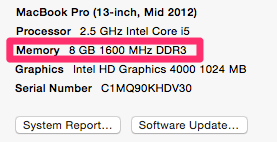

- #Best ram configuration for mac pro 2013 drivers#
- #Best ram configuration for mac pro 2013 upgrade#
- #Best ram configuration for mac pro 2013 professional#
- #Best ram configuration for mac pro 2013 windows#
Our favorite configuration is the M1 MacBook Pro with 512GB of storage and 8GB of unified memory. The MacBook Pro 13 is the Apple machine of choice for professionals who want an extra-portable laptop that can still handle more demanding tasks.
#Best ram configuration for mac pro 2013 upgrade#
In my next article in this series, I’ll explore the upgrade path strategies to go from an iMac to a Mac Pro. Fusion does support Apple’s latest OS and the list of known issues is quite short and doesn’t contain any showstoppers.

A careful check on VMware Fusion’s blog announcing Fusion 12, confirms that everything is fine. As for the graphic card, even going with the base configuration, it will be an upgrade from the one in my 2017 iMac.ĭepending on the timing, this Mac Pro will probably come with macOS Big Sur. Additional RAM will be upgrade to 192 GB by the replacement of the 4 × 8 GB R-RIMMS with a third-party RAM manufacturer with 6 × 32 GB R-DIMMS. Unless there are surprises, my configuration choice goes to the 12 cores CPU, 32 GB of RAM and 2 TB SSD. Sure, I’ll wait for November Apple Event as Apple could make some changes to their current Mac Pro offerings and pricing.

Lastly, the Mac Pro just came out in 2019, and there is still a lot of potential in it.Īll this being said, I’m not playing fool.
#Best ram configuration for mac pro 2013 drivers#
Four, many drivers will need to be upgraded to support the new architecture on which many pieces of equipment are based-on to operate. Apple will go after higher volume products first like the MacBook line, which will benefit from Apple Silicon. Second, the Mac Pro is a low-volume product. These applications are not going to be the first to be optimized unless there is a clear performance advantage, something that is unproven at this time for high-end machines like the Mac Pro.
#Best ram configuration for mac pro 2013 professional#
First, many professional users rely on applications currently not optimized for ARM processors. The Mac Pro will probably be the last machine to transition to the ARM architecture.
#Best ram configuration for mac pro 2013 windows#
It is a dealbreaker for me as I need Windows Servers in my SDDC environment for services like Active Directory. Windows running inside virtual machines on ARM is not possible right now and no plan was announced. While it is probably safe to bet on VMware to make a version of Fusion available for the upcoming Apple Silicon Macs, Windows virtualization is probably not coming anytime soon. The question is: should I wait and see what Apple has in store before taking the plunge with an Intel-based Mac Pro? The short answer is no. It’s a major endeavour for Apple and for the users like me. What about the upcoming Apple Silicon Macs?Īt the WWDC conference last June, Apple officially announced its intention to transition to the ARM architecture, under the name of Apple Silicon, for the Mac product line. Internal on-board ports are USB and eSATA capable only which doesn’t help. An external USB-C drive runs slower because the USB channels are not directly tied to the PCIe bus. As explained in my previous article, virtual machines can consume a lot of space and the best place to run them is on the internal SSD. On the Mac Pro, I’ll have to upgrade to a 2 TB SSD and it isn’t cheap. I’m currently using an iMac which comes with a 1 TB SSD drive that is 90% full. I’ll take that even if it enables only a marginal improvement. With this configuration, as per Apple documentation, the memory clock speed increases to 2933 MHz. The next step is to upgrade to a 3.3 GHz version which has 12 cores. The base Mac Pro configuration comes with 32 GB of RAM (4 × 8 GB R-DIMM) that is running at 2666 MHz and a Xeon W with an 8-core CPU. The more CPU cores, the more RAM and disk space I’ll be able to afford, the better the chances to get a future proof Mac Pro configuration. In my previous article, “ The SDDCbox Project - Part #2 - Testing the Waters“, I exposed my testing strategy which involved testing a few virtual machines on my iMac to get a sense of the type of hardware I will need for my SDDCbox project.


 0 kommentar(er)
0 kommentar(er)
